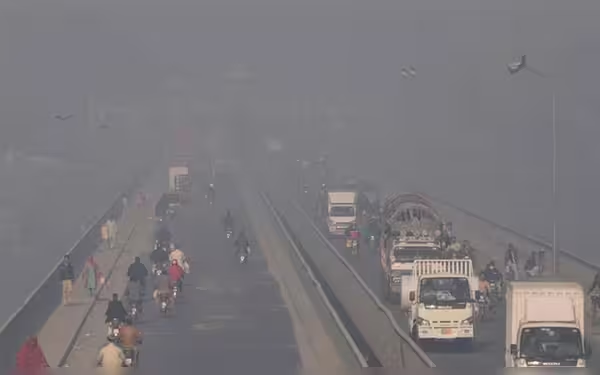Thursday, November 7, 2024 09:56 AM
Lahore Ranks Second in Global Pollution Crisis
- Lahore's air quality index reaches alarming levels.
- Government implements Green Lockdown to combat smog.
- Primary schools closed to protect children's health.
 Image Credits: gnnhd
Image Credits: gnnhdLahore faces severe pollution, ranking second globally. Government enforces measures to protect health and combat smog crisis.
Lahore, the vibrant provincial capital of Pakistan, is currently facing a severe environmental crisis as it ranks second among the world's most polluted cities. With an alarming average smog rate of 414, the situation has raised significant concerns among residents and authorities alike. The Air Quality Index (AQI) readings in various parts of the city are particularly troubling, with DHA Phase VIII recording a staggering 714 and Syed Marabat Ali Road at 613. Although the average smog levels have decreased compared to yesterday, the overall air quality remains a pressing issue.
In response to this dire situation, the government has taken proactive measures to safeguard the health of its youngest citizens. Primary schools in Lahore will observe holidays from November 4 to November 9, allowing children to stay indoors and avoid exposure to the hazardous air. Additionally, the Department of Environment has implemented a ban on heavy vehicles entering Lahore on Fridays and Sundays, aiming to reduce the number of pollutants in the air.
To further combat the smog, a Green Lockdown has been initiated in key areas such as Shimla Pahari, Abbott Road, Davies Road, Empress Road, Kashmir Road, and Durand Road. This lockdown includes restrictions on motorcycle Chingchi rickshaws, which are now prohibited from using these highways. Traffic wardens have been deployed to enforce these measures, including the installation of barriers to control traffic flow. Moreover, sweeping in open spaces without sprinklers has been banned, and barbeque shops are required to close by 8:00 PM to minimize smoke emissions.
As part of the Green Lockdown, the large parking lot outside the Shimla Pahari NADRA office has been relocated to an alternative open space for a month, further emphasizing the city's commitment to tackling pollution. Meanwhile, the Department of Meteorology has forecasted that Lahore's minimum temperature will drop to 19 degrees Celsius, while the maximum is expected to reach 31 degrees Celsius, indicating a shift in weather patterns that could also influence air quality.
The situation in Lahore serves as a stark reminder of the urgent need for collective action to address environmental challenges. While the government has taken steps to mitigate the impact of pollution, it is crucial for citizens to remain vigilant and adopt practices that contribute to cleaner air. Simple actions, such as reducing vehicle use, supporting public transport, and planting trees, can collectively make a significant difference. As Lahore grapples with its pollution crisis, it is imperative for everyone to play their part in fostering a healthier environment for future generations.













